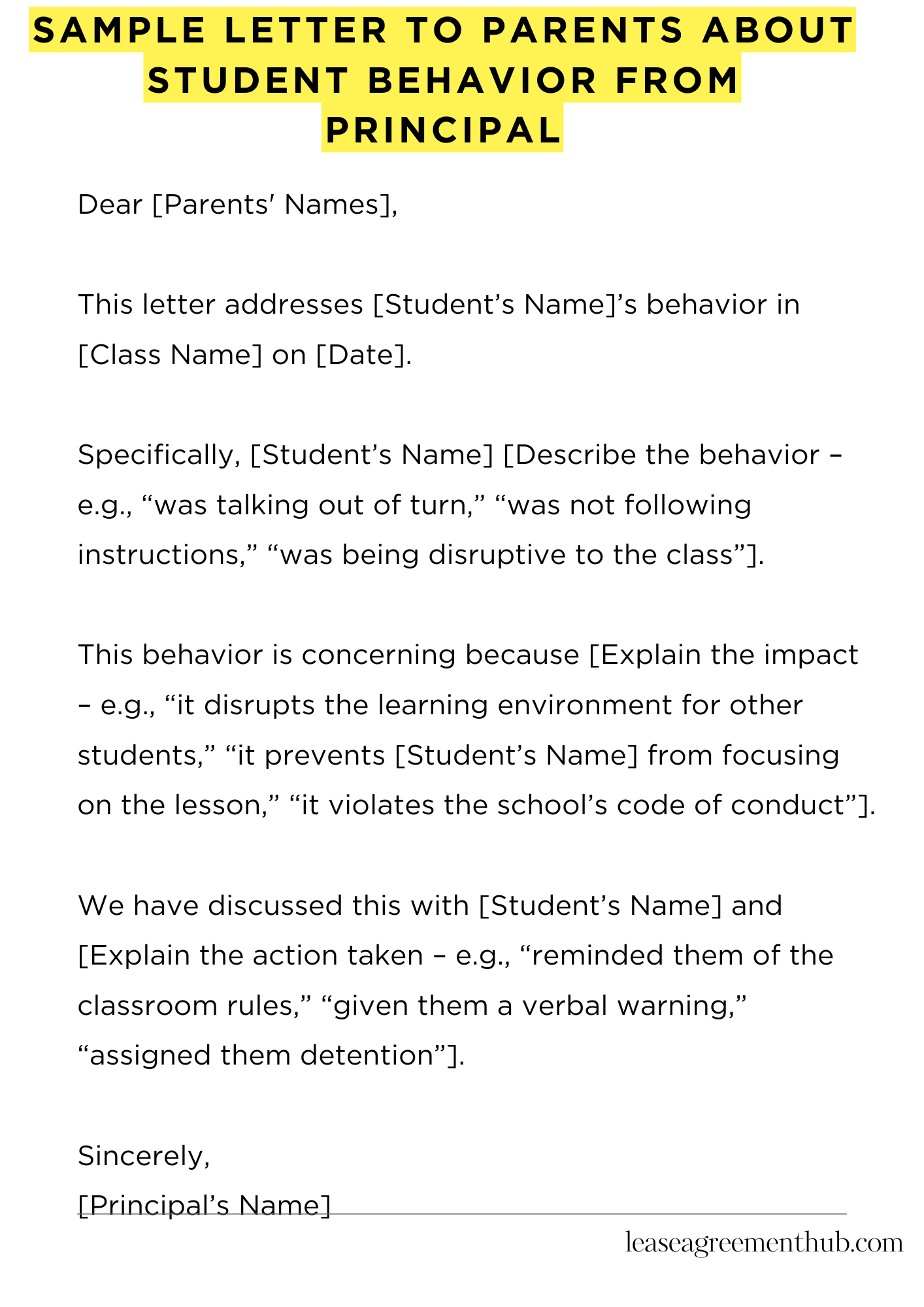A “Sample Letter To Parents About Student Behavior From Principal” is a formal note. It addresses a child’s actions at school. Principals use it to inform parents of issues. These issues can range from minor disruptions to serious misconduct.
Need to write such a letter? We’ve got you covered. This article provides sample letters. These samples will help you communicate effectively.
We offer templates for various situations. Use our samples to draft your own letters. Make the process easier and clearer.
Sample Letter To Parents About Student Behavior From Principal
[Your School’s Letterhead]
[Date]
Dear [Parents’ Names],
This letter addresses [Student’s Name]’s behavior in [Class Name] on [Date].
Specifically, [Student’s Name] [Describe the behavior – e.g., “was talking out of turn,” “was not following instructions,” “was being disruptive to the class”].
This behavior is concerning because [Explain the impact – e.g., “it disrupts the learning environment for other students,” “it prevents [Student’s Name] from focusing on the lesson,” “it violates the school’s code of conduct”].
We have discussed this with [Student’s Name] and [Explain the action taken – e.g., “reminded them of the classroom rules,” “given them a verbal warning,” “assigned them detention”].
We request your support in addressing this issue. Please discuss this with [Student’s Name] and reinforce the importance of appropriate behavior at school.
We believe that by working together, we can help [Student’s Name] improve their behavior and succeed academically.
Please feel free to contact me at [Phone Number] or [Email Address] to discuss this further.
Sincerely,
[Principal’s Name]

How to Write Letter To Parents About Student Behavior From Principal
1. Crafting a Concise and Pertinent Subject Line
The subject line is your initial communiqué. It should be succinct and immediately apprise parents of the letter’s essence. Avoid ambiguity; clarity is paramount.
- Example: “Regarding [Student’s Name]’s Conduct in [Class/Location]”
- Another Option: “Concerning [Student’s Name]’s Behavior on [Date]”
2. Penning a Respectful and Empathetic Salutation
Begin with a salutation that acknowledges parents with deference. A personalized greeting fosters a more receptive atmosphere.
- Example: “Dear Mr. and Mrs. [Parent’s Last Name],”
- Alternative: “Dear [Parent’s Name],” (if you know only one parent)
- Avoid overly casual greetings. Maintain a professional register.
3. Articulating the Behavioral Incident with Precision
The body of your letter necessitates a meticulous account of the concerning behavior. Specify the date, time, location, and individuals involved. Objectivity is indispensable.
- State the facts without embellishment or conjecture.
- Example: “On October 26, 2023, during third-period English class, [Student’s Name] engaged in disruptive behavior by [specific action].”
- Include any mitigating circumstances, if applicable.
4. Elucidating the Impact of the Student’s Actions
Detail how the student’s behavior affected the learning environment or other students. Emphasize the repercussions of the actions, demonstrating the gravity of the matter.
- Example: “This behavior disrupted the class, impeding other students’ ability to concentrate and learn effectively.”
- Explain any safety concerns arising from the student’s actions.
5. Proposing Collaborative Solutions and Remedial Actions
Present a plan for addressing the behavior and preventing its recurrence. This could involve school-based interventions, parental involvement, or external support.
- Suggest a meeting to discuss the matter further.
- Example: “We propose a meeting with you, [Student’s Name], and myself to formulate a behavior improvement plan.”
- Outline any disciplinary actions being taken by the school.
6. Reiterating Commitment to Student Success
Reassure parents that the school’s primary objective is the student’s holistic development and success. Underscore your dedication to working collaboratively.
- Example: “We are committed to supporting [Student’s Name]’s academic and behavioral growth and believe that through collaboration, we can achieve positive outcomes.”
- Express optimism for a successful resolution.
7. Employing a Cordial and Professional Closing
Conclude with a formal closing that conveys respect and openness to further dialogue. Provide contact information for ease of communication.
- Example: “Sincerely,” or “Respectfully,”
- Include your full name, title, and contact information (phone number and email address).
- Offer availability for a follow-up conversation.
Frequently Asked Questions: Student Behavior Letters
This section addresses common inquiries regarding letters sent to parents from the principal concerning student behavior. It aims to provide clarity on the purpose, content, and implications of such communications.
Why did I receive a letter about my child’s behavior?
The letter indicates that your child’s behavior at school has raised concerns that require your attention and collaboration to address.
What kind of behavior warrants a letter from the principal?
Serious or repeated instances of disruptive behavior, violation of school rules, or actions that negatively impact the learning environment typically warrant such communication.
What information will the letter contain?
The letter will detail the specific behavior observed, the date and time of the incident, and any consequences that have been or will be implemented.
What is the purpose of this letter?
The primary purpose is to inform you of the situation, seek your support in addressing the behavior, and work together to ensure a positive and productive school experience for your child.
What should I do after receiving this letter?
Review the letter carefully, discuss the matter with your child, and contact the school to schedule a meeting with the principal or relevant staff to discuss the situation further and develop a collaborative plan of action.
Related: